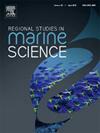Phytoplankton assemblage shifts from whale shark off-season to in-season in Donsol, Philippines influenced by temperature and nutrients
IF 2.4
4区 环境科学与生态学
Q3 ECOLOGY
引用次数: 0
Abstract
Donsol, Sorsogon, Philippines experiences an annual aggregation of the whale sharks Rhincodon typus. This was anecdotally associated with high plankton prey, though the factors driving this are not understood. Here, we studied how phytoplankton and environmental conditions related to seasonal sightings of whale sharks in Donsol from 2017 to 2018. Sightings were categorized into “off-season” (September-November), and “in-season” (February-May). We collected and analyzed surface samples of phytoplankton and physicochemical parameters from twelve stations and used Hierarchical Modeling of Species Communities (HMSC) to discern potential associations of abiotic and biotic parameters. Environmental filtering largely structured the phytoplankton, with temperature and silicate as key variation predictors. Dinoflagellates emerged as off-season indicators, while diatoms represented in-season. The whale shark in-season was thus characterized by cooler temperatures, higher rainfall, high silicate concentrations, and an increase in diatom abundance and dominance. Riverine input may have supplied nutrients to the site favoring diatom growth.
受温度和营养物质影响,菲律宾 Donsol 鲸鲨淡季和旺季浮游植物组合发生变化
菲律宾索索贡(Sorsogon)的东索尔(Donsol)每年都会出现鲸鲨聚集的现象。据说这与浮游生物猎物较多有关,但其驱动因素尚不清楚。在此,我们研究了浮游植物和环境条件与 2017 年至 2018 年期间在 Donsol 鲸鲨季节性目击的关系。目击事件分为 "淡季"(9-11 月)和 "旺季"(2-5 月)。我们收集并分析了 12 个站点的浮游植物表面样本和理化参数,并使用物种群落层次模型(HMSC)来识别非生物和生物参数的潜在关联。环境过滤在很大程度上决定了浮游植物的结构,其中温度和硅酸盐是关键的变化预测因子。甲藻是淡季指标,而硅藻则代表淡季。因此,鲸鲨淡季的特点是气温较低、降雨量较高、硅酸盐浓度较高、硅藻丰度和优势度增加。河流输入可能为该地点提供了有利于硅藻生长的营养物质。
本文章由计算机程序翻译,如有差异,请以英文原文为准。
求助全文
约1分钟内获得全文
求助全文
来源期刊

Regional Studies in Marine Science
Agricultural and Biological Sciences-Ecology, Evolution, Behavior and Systematics
CiteScore
3.90
自引率
4.80%
发文量
336
审稿时长
69 days
期刊介绍:
REGIONAL STUDIES IN MARINE SCIENCE will publish scientifically sound papers on regional aspects of maritime and marine resources in estuaries, coastal zones, continental shelf, the seas and oceans.
 求助内容:
求助内容: 应助结果提醒方式:
应助结果提醒方式:


